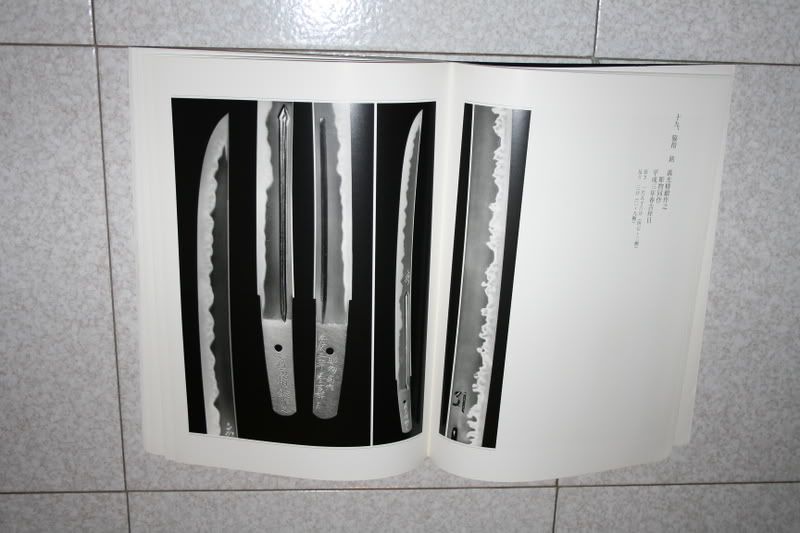
 |
|
|||||||
 |
|
|
Thread Tools | Search this Thread | Display Modes |
|
|
|
|
#1 |
|
Member
Join Date: May 2006
Location: Magenta, Northern Italy
Posts: 123
|
Hi all.
As occasionally I've seen interest in japanese weaponry too on this board, I dare to post this here too. I’ve just received my signed copy of the Hayashibara Museum exhibition catalogue of “Ono Yoshimitsu’s World of Juka Choji” and I would like to share some info about it. It is divided into two sections: “Pursuing Koto Bizen” and “The Ayumi Chronology”, a chronological look at Ono’s works entered into the annual exhibition of the Nihon Bijutsu Token Hozon Kyokai (The Japanese Art Sword Preservation Society) between the years 1983-1991. In Pursuing Koto Bizen, Kashima Susumu links 26 blades made by Yoshimitsu to the periods they are inspired to, from the Ko-Bizen perfected Japanese sword to the Sue-Bizen chumon-uchi (special order swords) . Measurements : 36,50 x 25,50 x 2,00 cm 154 pages, 106 black and white high quality, 30x22 cm pictures of the 26 blades, 3 color pictures of koshirae and a black and white portrait of the smith. Japanese language with English translation in a separate CD. No ISBN number Available thru Budoshop, budos@budoshop.co.jp Kakuta-San speaks English and has the renowned Japanese kindness. Get in touch with him for pricing as the shipping fees are something to deal with and to ask if it is still possible to have your copy signed by Ono Yoshimitsu. Cover :  Hereunder I copy and paste the index of the book : Ono Yoshimitsu’s World of Juka-Choji Pursuing Koto Bizen / The Ayumi Chronology Contents Exhibition Introduction…..Director of The Hayashibara Museum—Okuma Ritsuji Memories……………………………………... Finance minister—Hashimoto Ryutaro Proudly Presenting our Arts to the World…………..President of the Hayashibara Corporation—Hayashibara Ken Carrying the Bizen Tradition-Ono Yoshimitsu……………………..Kashima Susumu The Yoshimitsu Exhibition………………………………………..Yoshihara Yoshindo Plates Pursuing Koto Bizen………………………………………………………………… The Ayumi Chronology……………………………………………………… Texts Pursuing Koto Bizen…………………………………………………Kashima Susumu Ono Yoshimitsu—Pursuing Koto Bizen……….Kashima Sususmu/Ono Yoshimitsu The Ayumi Chronology……………………..…………………...…..Kashima Susumu The Ayumi Chronology 1983-1991……….….……………………….Ono Yoshimitsu Profile—Ono Yoshimitsu Epilogue Acknowledgements Sword Photography — Okisato Fujishiro Portrait Photography and Photography — Tom Kishida Catalogue design — Kanai Kouji Editor — Kobayashi Kakushi Translation — Paul Martin The high quality black and white pictures dimensions are huge, 30x22 cm to be exact, placing them amongst the biggest in my library, taken for the upper part, lower part (with both sides of nakago) and whole blade, many with an additional picture of the central part with even more evident and amazing details of the Hamon, placed in the frontal page of the caption, caption that has details and historical description written by both Ono Yoshimitsu and Kashima Susumu. You find the full translation in the part 8 of the CD. This is an example (blade and description doesn't match INTENTIONALLY, my choice for copyright )  Quote… …omissis… Tachi (Long sword) Inscription: Front: Etchigo (no) kuni (ni) oite Yoshimitsu kore (wo) tsukuru (Yoshimitsu made this in Etchigo Province- Niigata) Back: Heisei san nen aki kissho bi (An auspicious day in Fall 1991) Length: 77.8cm (2 Shaku, 5 sun, 6 bu, 5 rin) Curvature: 2.8cm (9 bu, 2 rin) Kashima Susumu This tachi displays the style of workmanship of the Ichimonji school from the early Kamakura period. The blade is quite narrow and is koshi-zori with funbari and a small point section that is shaped like the head of a barracuda. The forging is a tight ko-itame hada and displays utsuri. The hamon is a large choji-midare that turns into juka-choji with ko-ashi and plenty of yo mixed in. The nioi-guchi is tight and the boshi is a deep midare-komi in an ichimai style with kaeri. This tachi has met its aim of attaining the feeling of the early ‘ichi’ signed Kamakura Ichimonji tachi, and displays the characteristics well. Ono Yoshimitsu Early Kamakura blades have a beautiful shape. A flamboyant juka-choji can be seen creeping up to the shinogi. After this, they began experimenting with different juka-choji styles. As this blade’s mihaba was narrow, it was difficult to produce a flamboyant hamon. Polished by Inutsuka Tsuneyuki Habaki by Nakamura Saido Shirasaya by Sakai Toshifumi … unquote I really like Ono's works and I especially enjoied this catalogue that links modern blades to specific historical context in a chronological way and because of Paul Martin's translation that makes fully understandable the amazing work of Ono even to people not familiar with japanese language. Thanks for your time. Last edited by tsubame1; 28th April 2007 at 12:56 PM. |
|
|

|
|
|
#2 |
|
Member
Join Date: Mar 2005
Posts: 116
|
thank you for posting
thats a great book.. with excellent details and dimensions accurate photo's ... wonderful !! Greg  
|
|
|

|
 |
|
|